Wellsburg Reformed Church
October 1896 marks the foundation of the Wellsburg Reformed Church. Until this time, no church had been established within Wellsburg. The population was mainly Eastfriesens who were very strong in their faith and depended upon the Presbyterians to the southeast and northwest and the Christian Reformed church west of Wellsburg for their spiritual guidance. With the influx of population, the Pleasant Prairie Classis of the Reformed Church in America saw the need for a ministry within the town. Rev. Geert Veenker, a classical missionary, was the progenitor of this church and had a great following. On June 2, 1897, the Wellsburg Reformed Church's petition for organization was granted. There were 42 charter members with the consistory of Jacob Peters and Jurgen Lutterman, elders; and Koene Reiter, Claas Primus and Fred B Hook, deacons.
Not until June 1898 did the members build the first church. Until this point, regular preaching was done in the Wellsburg schoolhouse and the Lutterman schoolhouse, which was south of Wellsburg. In 1913, the church became too small to hold the ever growing congregation and a new church was built. In 1977, the third and present building, was erected.
The German language was preached upon its establishment. During World War I, the state's command was for sermons to be preached in English which was obeyed. However, at the completion of the war the congregation voted to return to the German language.
Other organizations which supported the church's efforts were the Ladies Aid Society which was organized in 1901. The Guild for Christian Service was established in 1960, which had its origin in the Dorcas Society which was organized in 1906. Rev. Landsiedel organized the Young Men's Club, now known as the Men's Brotherhood, in 1940. Other organizations are the Reformed Church Youth Fellowship, Couple's Club, and the various Choir groups.
Wellsburg Reformed Church, 1897-1997
Beginnings
Theilken - Landsiedel - 1897-1946
It was during the fifth and sixth decades of the past century that the western part of Grundy County was first settled by our sturdy and thrifty Eastfriesens. Coming to this country they first landed in and around Freeport, Illinois, and later on moved here with the intention of establishing their own homes. They possessed one quality of character, which speaks for them and which they could not deny; to be faithful and loyal to their religious training and education. This they had received in the land of their birth, and now considered it their highest duty to preserve it as their most precious treasure, to maintain and cultivate the same in their adopted fatherland, for they were convinced that on it depended their spiritual as well as their temporal welfare.In those days there was no Wellsburg. They were served by the Presbyterians southeast and northwest and by the Christian Reformed church west of what is now Wellsburg. Later on Wellsburg was founded, receiving its name from Mr. George Wells, who was a large land-owner in this community. By and by Wellsburg and its vicinity was settled by more Eastfriesens coming into the neighborhood. Several denominations now realized that the prospect of starting a mission here in Wellsburg was very promising. Concentrated efforts were made to win the field; the schoolhouses were used for services.
It was in October of the year 1896 that this community gave the Rev. Geert Veenker, then classical missionary of the Pleasant Prairie Classis of the Reformed Church in America, a splendid opening for a new mission field. Yea, when he entered he found the field white already to harvest.
The ingathering and founding of the Wellsburg Reformed congregation was entirely out of the ordinary. While most missions have a meager start and often struggle for a mere existence for years, their prospects giving just enough hope to make their pastors desperate, it has been different with this congregation. The prospects of the Wellsburg Reformed Church from its very beginning have not only been hopeful, but inspiring, filling its pastors with zeal and enthusiasm.
Since there was no church in the town of Wellsburg, when our classical missionary first came here in October, 1896, he was not slow in realizing that here was a very good mission field. Upon visiting the neighborhood, he found all willing and eager to be served with the Word and the Holy Sacraments. Regular preaching was done in the Wellsburg schoolhouse and in the Lutterman schoolhouse south of town. Rev. Daniel Schaefer, who at that time served the congregation south of Parkersburg, loyally supported Rev. G. Veenker in his efforts. The labors of these brothers were so successful that after eight months the Wellsburg mission petitioned the Pleasant Prairie Classis for organization. The petition was granted. The Wellsburg Reformed Church was organized June 2, 1897, with 42 charter members and its first consistory was composed of Jacob Peters and Jurgen Lutterman, elders; and Koene Reiter, Claas Primus and Fred B. Hook, deacons. Preceding the organization there was a short service, and a sermon was preached on Luke 10:42. From that time on, the mission was served by two men for the next two years: the Rev. John Mueller (dead since 1909) and a student of theology, J. C. Theilken. The mission was served by the student during the vacation months of 1897 and 1898, the Rev. John Mueller being its pastor the rest of the time.
The people were not satisfied with a schoolhouse for their place of worship. As they were eager to have their own church, the necessary steps were taken in soliciting funds so that the first church, now called the Doyen church (because it was bought by them when it was replaced by a new church) was erected in the spring of 1898 and solemnly dedicated in June, 1898, the Rev. John Mueller preaching the dedication sermon.
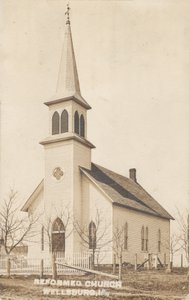 First church building built in 1898
First church building built in 1898From this time on there was no more preaching in the Lutterman schoolhouse, this neighborhood going to Wellsburg to worship. In order that the church might be able from then on to maintain a salaried pastor, the Board of Domestic Missions was petitioned for support until it became self-sustaining in the fall of 1907. In the winter of 1899, the congregation gave the student J. G. Theilken a call to become its first regular pastor. He accepted and after finishing his studies at Holland, Michigan, was installed by the Pleasant Prairie Classis in May, 1899. The Rev. J. C. Theilken was pastor of the Wellsburg Reformed Church for 14 years, 7 months and 12 days, with an interim of 15 months (April 1908 - July 1909) during which he served the Belmond congregation, which called him in 1908, but in 1909 the Wellsburg congregation was successful in recalling its former pastor. During his pastorate the congregation grew by leaps and bounds, and it was a very healthy growth. It was at this time that the congregation decided to celebrate its first Missionfest, and according to the minutes of the church, the same was held August 16, 1899. In June, 1899, the congregation decided to build its own parsonage, but as they lacked the necessary means, the Church Building Fund was petitioned through the Pleasant Prairie Classis for a loan of $500, which was granted. The Board retained a mortgage on the church for security. The building committee for erection of the parsonage was composed of Jacob Peters, Claas Primus, Jurgen Lutterman, Sr., Jacob Jaspers and George Wells. It was later on enlarged by an addition in April, 1904.
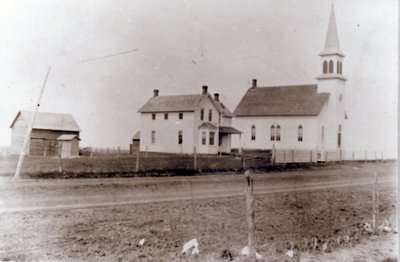 First church building and parsonage
First church building and parsonageAfter a few years the church was found inadequate. The building was much too small. A new church had to be built! So in 1913, after fifteen years of existence, the congregation resolved to build a new church that would afford ample room for the near future. After a building committee had been appointed, composed of W. I. Knock, Arend Meyer, Harm S. Meyer, John Paterni, John W. Riekena, with their pastor for chairman, the present fine brick structure was built at an expense of $16,000 to $17,000, which included the pews, pipe-organ, etc. The new church was dedicated on December 12, 1913. The Rev. G. Schnuecker preached the dedication sermon.
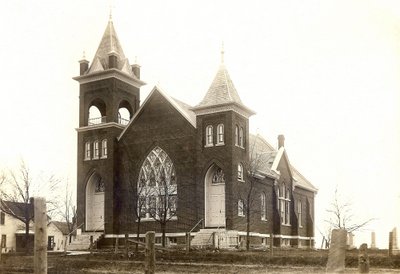 Second church building built in 1913
Second church building built in 1913The Rev. J. C. Theilken surely was a successful minister and much beloved. And yet a few months after dedicating the new church, he shocked the congregation by resigning and accepting a call to Forreston, Illionis. He was not seeking his own interests, but that of the church. During the period from 1897 to 1914, under his charge, the 42 charter members increased to 54, to 66 families adhering and contributing to the support of the church.
The church pulpit was vacant for almost one year. Many ministers were considered as candidates. Finally the Rev. Wm. Landsiedel was called to be pastor and teacher of the church. He accepted the call and came in the month October, 1915.
From records we may safely be confirmed that this was his heartfelt testimony and conviction when he had these words inserted in the twenty-seventy anniversary booklet.
"I am not ashamed of the gospel of Christ; for it is the power of God unto salvation to everyone that believeth."
In 1918 the congregation built a beautiful modern manse at the cost of $12,000. Those who served on the building committee besides the pastor were: Chris Neessen, Andrew Murra, D. J. Beving, D. J. Peters, Harm Okones, and Fred Terfehn. A sum of money was borrowed from the church to finance the building of the parsonage and was paid back already in 1924. The congregation was happy to be entirely free from financial debts.
The past records of the church indicate that World War I did not pass by unheeded. Fourteen young men, in the flower of their youth, were drafted. All of them did not come back to be greeted with love and joy from their homes and from the community. Four young men were sent back to be placed in their final resting place in our cemetery.
It was in 1922 when the congregation was permitted to celebrate its 25th and in 1937 its 40th anniversaries which gave ample proof that the work founded here is the Lord's. Those were great events when each one in the congregation could reflect and recall some of the highlights of the history of the church. Most significant about these anniversaries is the realization of the fellowship of believers.
|
--Wellsburg Reformed Church Choir ca. 1924-- Back row standing: A. Terfehn, L. Schmidt, K. Murra, A. Terfehn, A. Ohling, W. Landsiedel, J. Ohling, J. Schmidt, G. Paterni, T. Bunger, H. Paterni Second row: G. Harms, L. Juetting, H. Ohling, D. Neessen, C. Schoolman, A. G. Neessen, F. Murra Front row kneeling: G. Harms, J. Beving, W. Harms, E. Schoolman, F. Terfehn |
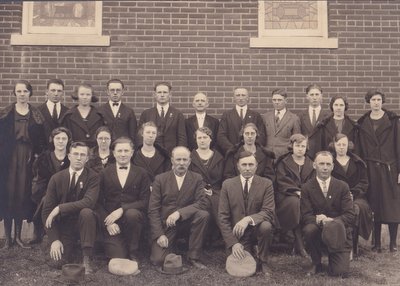 |
|
--Wellsburg Reformed Church Young People's Society ca. 1924-- Back row standing: L. Lindaman, A. Riekena, I. Bunger, G. Harms, L. Ruter, A Neessen, A. Terfehn, F. Murra, G. Ruter, A. Hickamn, G. Lindaman, H. Paterni, A. Okones, H. Ohling, L. Thorn, T. Bunger, K. Murra Front row kneeling: A. Ohling, G. Schmidt, H. Okones, J. Ohling, F. Ruter, T. Bunger, G. Harms, G. Paterni, N. Okones, L. Schmidt, J. Beving, A. Terfehn, P. Ruter |
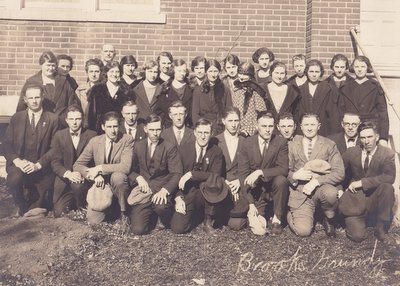 |
The Rev. Landsiedel had labored here for almost 31 years. With many of this flock, he had shared joy and sorrow. During this time, World War II called many of our young men into active military service. Two of them gave their lives for their country. One of the sons of the church, Richard Beving, was ordained as a minister of the gospel in 1945. In his ministry, the Rev. Landsiedel wrestled with many problems and difficulties that arose in trying times. By God's grace and by his able leadership used of the Lord, he was able to surmount them. God blessed him with a strong bodily constitution which he consecrated to the Lord and gave his untiring efforts and endeavors in services rendered. But in the last few years his health began to fail gradually, still he performed his duties almost to the end of his life. On May 3, 1946 he passed to his eternal home. His memory still is blessed and cherished by the congregation.
Jurgens - Poppen - Wolbrink
1946-1979
After a pulpit vacancy of several months due to the death of Rev. Landsiedel, a call was extended to the Rev. Edward Jurgens of Little Rock, Iowa. The call was accepted and the Rev. Edward Jurgens was installed on the evening of December 29, 1946. After Rev. Jurgens' arrival, the German service was discontinued and English was used exclusively.The congregation celebrated the 50th anniversary of their church in 1947. Speakers from the occasion were the Rev. F. Reeverts and the Rev. J. M. DeVries, both of Sibley, Iowa. Mrs. Theilken, wife of a former pastor was present to fellowship with us and renew old acquaintances.
More changes were taking place. The congregation held their annual meeting on January 2, 1948, and approved the individual communion cups. They were first used at a communion service in June, 1948. Also, a tape recording was made of the Sunday morning worship service and was available to shut-ins. A building fund was initiated at the annual meeting in December, 1951. Prior to this date, a special offering had been received for this purpose.
In 1953, the Rev. Jurgens accepted a call to Clara City, Minnesota and left our congregation in the fall of the year.
After a few months of vacancy, the Rev. George C. Poppen of Fon du Lac, Wisconsin accepted the call that was extended to him, and he was installed January 4, 1954. With the passing of time, more changes were made. The number of deacons and elders were increased from three to four and a rotation system was started in 1955. The order of worship was changed at the Congregational meeting in 1958. Morning worship was to be held at 9:30 a.m. and Sunday School at 10:45. It was decided to subscribe to the Church Herald on an every family basis for a years trial. In the same year, the Sunday School teachers became concerned about the effectiveness of their teaching due to the crowded conditions in the church building. It was brought to the Consistory for consideration. As in every building program, there was the problem of finances. The congregation was canvassed for pledges, and the plans for the educational building were approved at the congregational meeting on January 11, 1960. The following were chosen to serve on the building committee: Leonard Gelder, Chr., Andrew Ohling, Henry Hippen, Raymond Riebkes, Harris Peters and Sam Paterni. Serving on the consistory and working with the building committee were Andrew Ohling, Abe Murra, George Anderson, Herman Stahl, Bernard A. Engelkes, Edward R. Harms, Leonard Gelder, Martin Boeke, Fred Gross, William Schmidt, Elmer Finke, Peter Ruter, Neil Okones, and church treasurer, Alle Murra. Ground breaking ceremonies took place on Sunday afternoon, March 26, 1961. Many hours were spent in planning and laboring and construction began in May, 1961. It was constructed at a cost of $90,000 and consists of a social hall seating 300 persons, coat room, kitchen, pastor's study, and storage rooms. On the basement floor there are ten classrooms.
The first Sunday School classes were held in the building July 22, 1962. The formal dedication took place September 2, 1962, in connection with the 65th anniversary of the church. The Rev. Edward Jurgens of Clara City, Minnesota and the Rev. George Poppen delivered dedication and anniversary messages.
The Rev. George Poppen accepted a call to the Wichert Community church in St. Anne, Illinois, and left our church in February, 1963.
Following the departure of the Poppen family, a call was extended to the Rev. Gideon R. Wolbrink of Erie, Illinois. The call was accepted and the Rev. and Mrs. Wolbrink and their four children, Janie, Paul, Harriet and Martha moved into the parsonage. The Rev. Wolbrink was installed July 11, 1963.
During the Rev. Wolbrink's ministry, final payment was made on the Educational Building, and a mortgage burning ceremony was held in the morning worship service June 9, 1968.
Mrs. Wolbrink has noted in a personal diary kept of the years of their pastorate that -- "Building plans were a main item stressed when Gideon was called, but the building program was an 'on-again-off-again' affair. There was an indebtedness of $35,000 on the Fellowship Building when we came in '63. Sometimes the General Fund was too low to make the interest payment, so a loan from the Mission Fund was needed. Finally, the mortgage was burned in an a.m. service. We began to think that we would not see a new sanctuary built in our term of service (Gideon had been diagnosed as having Parkinson's disease in March of '72). But a vote of the congregation in '76 expressed the desire to build. A committee was appointed and plans began in earnest. This time we must have been in step with God's timing as everything moved forward smoothly."
The vote to build a new church put many forces to work in short order. After a meaningful celebration of our country's bicentennial, the time came in October to hold the final Sunday services in the old building which had served as a community landmark for sixty-three years. The old church was lovingly disassembled, many items held over to be incorporated in a new setting and others held as treasured keepsakes by individual families. Ground breaking for the new project was held October 10, 1976. Appointed to serve on the Building Committee were Neil Okones, Chr., Mary Ascher, Helen Beving, Arnold Boekhoff, Abe Murra, John Ringena, and Keith Huisman. Consistory members serving at this time were the Rev. Wolbrink, president, Elders: Boyd Meyer, vice-president, Dale Murray, Arnold Arends, Larry Meyer, Deacons: Donald Huisman, Marvin Stahl, Delbert Ross, and John Flater. Plans were made to build on the original site and to connect the sanctuary to the educational building with the social hall to provide additional seating when needed. Work was begun in the late fall so that the winter season could be used to speed the project along. The original cornerstone was placed in its new location in a special ceremony on Sunday, June 19, 1977.
Incorporated into the beauty of the new structure were many appointments from the nave of the old building. The stained glass windows were restyled into panels retaining the color and original designs, the Anchor and the Crown, which were placed in prominent positions. The organ was rebuilt, enlarged and equipped with an electronic console. Later chimes would be added as a gift from the Memorial Fund. The pulpit, chairs, communion table, and baptismal font were kept for their beauty along with the frontispiece which is still the orderly arrangement of organ pipes with sculpted wood paneling that the past generations have admired and treasured. The original church bell installed in a new belfry regularly announces the services of worship.
On August 21, 1977, the congregation met for the first time in the new setting with the formal dedication being held September 25, 1977. The total cost of the project reached just over $200,000.
Rev. Wolbrink continued to serve a few more years until declining health encouraged his retirement in March of 1979. Through the urging of the consistory, their service extended to Easter Sunday. They elected to stay with us in Wellsburg and moved into their present residence. Reflecting on "change" during the span of time from seminary days to retirement and today, the Rev. Wolbrink pointed out that the emphasis was on strict order and formality of worship in the early years, and that in the present day the focus is on a trend to informal practices and fellowship.
Huitink - Boone
1979-1996
Reverend Roger Huitink
A call was extended to the Rev. Roger Huitink of Castlewood, South Dakota, on October 18, 1979. He accepted the call and moved his family, wife, Char, and daughter, Susan, to Wellsburg in December of that year. Installation services were held December 18, 1979.With a change in pastors comes a change in practices and new ideas to create renewed interest in the membership. As in all walks of life some innovations are more successful than others, but all are worthy of the effort. Some projects of note were the creative Maundy Thursday Communion Services, the formation of various prayer groups, Bible study classes and Care Groups which were formed to encourage the members to give much needed support to each other as well as answer to the needs of non-members. Elective Adult Sunday School classes were offered during the school year. A Family Living Project was launched in 1987 to encourage the strengthening of our educational programs through the encouragement of Christian family living. A Men's Chorus was established in 1980 and has provided much musical inspiration. A Coffee Fellowship was held after Sunday morning services as well as fellowship hour after the evening service once each month plus the occasional congregational potluck dinners which help to simulate family fellowship among the membership. An alphabetical rotation of members provided special greeters who welcomed one and all to our services and they also arranged for a special music presentation during the evening service (school year) or morning service (summer season).
The current church census indicates the effects of the mobile society and the economic climate around us. Although the change is not dramatic, it is an indicator of future trends. In 1979 we numbered 263 active communicant members and 90 baptized children. In 1987 we showed a record of 250 active communicant members and 79 baptized children. One of our number joined the ministry. The Reverend John Geerdes was installed as pastor of the Holly Springs Baptist Church in Holly Springs, Georgia.
Financially, the church operated under a slightly increased budget ($87,000) with a traditional emphasis on support for the mission projects of the Reformed Church in America. At that time the church was directly involved in the support of four missionary families: Carroll and Betty DeForest at Gray Hawk, Kentucky (Sunday School Project), Eugene and Joyce Vander Well of Taiwan, Harry and Pat Miersma of New Guinea, and the Director of Southern Normal Institute in Brewton, Alabama. The annual celebration of a Mission Fest continues to emphasize the major work of the Reformed Church in America both nationally and worldwide.
After serving our congregation for over nine years, Pastor Huitink accepted a call to Central Reformed Church in Oskaloosa, Iowa, in the spring of 1989.
Reverend Verlyn Boone
Our most recent pastorate began in the fall of 1989 when the Reverend Verlyn Boone of the Bethel Reformed Church in Leota, Minnesota, accepted the call to serve our congregation in Wellsburg, Iowa. The family moved into the parsonage in late summer - Pastor Verlyn and his wife, Sue, and sons, Adam and Andy. Installation services were held September 25, 1989.During the years of his leadership we saw the number of consistory members increase from eight to twelve, six deacons and six elders. The regular Sunday evening service became an Adult Bible Study service and in the past few years no evening services have been held during the summer months, June through August. However, our congregation has participated with other local churches in a "Church in the Park" series of services held on Sunday evening during July. Pastor Boone also introduced the "Bridge", a newsletter edited each month with information and inspiration material pertinent to each member of the congregation.
In the area of missions we now fund a "full support" for Harry and Pat Miersma serving in Africa. We also support the Southern Normal Institute of Brewton, Alabama.
Church property improvement include the cementing of the north parking lot in 1990, extensive roof repair of the Fellowship Hall and of the church proper in 1994. New replacement windows were installed on the first floor of the parsonage in the fall of 1996.
The Boone's were active community members while they lived in Wellsburg. It was early in their pastorate that a community pre-school was established partly through the efforts of Mrs. Boone who directed its operation for several years. An area in the lower level of the Educational Building was set aside for this purpose as a local mission project. The Discovery Pre-School has been very successful and is a continuing valuable service to the families of the Wellsburg area.
In the spring of 1996 a call was extended from the First Reformed Church in Hull, Iowa. Pastor Boone accepted. The family moved to their new location in June of 1996.
--Wellsburg Reformed Church, 1897-1997
List of Pastors
| Name | Years Served |
| Rev. John Mueller | 1897-1898 |
| J. G. Theilken (Theology student) | 1897-1898 vacation months |
| Rev. J. G. Theilken | 1899-1908 / 1909-1914 |
| Rev. Wm. Landsiedel | 1915-1946 |
| Rev. Edward Jurgens | 1946-1953 |
| Rev. George C. Poppen | 1954-1963 |
| Rev. Gideon Wolbrink | 1963-1979 |
| Rev. Roger Huitink | 1979-1989 |
| Rev. Verlyn Boone | 1989-1996 |
| Rev. Kevin VerHoeven | 1997-2001 |
| Rev. Todd Rempe | 2002-2009 |
| Pastor Mike Weaver | 2010-2013 |

